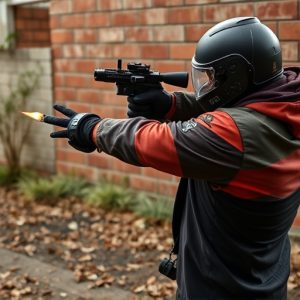Understanding Stun Gun Effectiveness: Power Ratings & Neuromuscular Impact
The neuromuscular effects of stun devices, caused by high-voltage, low-current electrical pulses, te…….
The neuromuscular effects of stun devices, caused by high-voltage, low-current electrical pulses, temporarily paralyze targets through disruption of nerve signals. Their effectiveness depends on power output, shock duration, and target attributes. Higher voltage enhances muscle contractions for quicker incapacitation but requires careful management to avoid harm. Proper training is essential for safe use, aiming, de-escalation, and legal awareness regarding stun gun ownership and regulations, which vary globally based on their neuromuscular impact.
“The neuromuscular effects of stun devices have sparked both curiosity and controversy. This article delves into the science behind these powerful tools, exploring how they disrupt the body’s neural system to cause incapacitation. We dissect the mechanism of action, analyze various rating systems for stopping power, and discuss factors influencing effectiveness.
Additionally, we address safety considerations, training needs, and legal frameworks surrounding stun guns, providing a comprehensive guide to understanding their potential and limitations.”
- Understanding Stun Guns and Their Mechanism of Action
- The Science Behind Neuromuscular Effects
- Rating Systems for Stopping Power: What They Measure
- Factors Influencing Stun Device Effectiveness
- Safety Considerations and Training for Stun Gun Use
- Legal Implications and Regulatory Frameworks
Understanding Stun Guns and Their Mechanism of Action
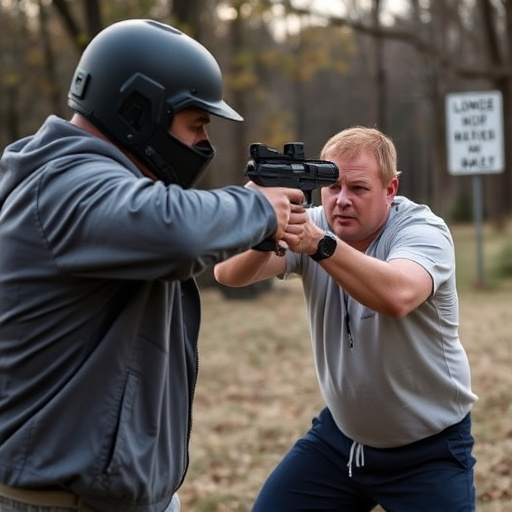
Stun guns, also known as electronic control devices (ECDs), are non-lethal weapons designed to temporarily incapacitate a target through a powerful electric shock. Their primary mode of action lies in disrupting the neuromuscular system. When activated, these devices emit an electric current that interferes with nerve impulses and muscle contractions, leading to muscular paralysis and disorientation. This disruption is achieved by delivering a high-voltage, low-current electrical pulse directly into the body through two prongs or electrodes.
The neuromuscular effects of stun devices are rapid and intense, causing the target to experience a loss of balance, strength, and control over their muscles. This sudden incapacitation can last for several minutes, providing users with enough time to disable or escape from a potential threat. It’s important to note that while stun guns offer a non-lethal alternative to firearms, their effectiveness depends on various factors, including the device’s power output, the duration of the shock, and the target’s physical attributes and resistance.
The Science Behind Neuromuscular Effects
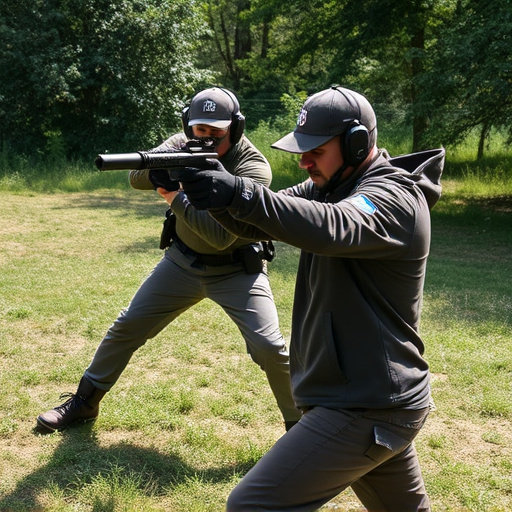
The effectiveness of a stun gun is tied intricately to its ability to induce neuromuscular effects in the target. When activated, stun devices emit an electrical charge that disrupts the electrical signals traveling between the brain and muscles, leading to temporary paralysis. This interference with the neuromuscular system causes the target’s muscles to contract involuntarily, resulting in loss of balance, coordination, and strength. The intensity of these effects depends on factors like voltage, current, pulse width, and contact points, all contributing to what is commonly referred to as stopping power.
Research into the neuromuscular effects of stun devices has shown that the electrical impulse can cause significant muscle contractions, often leading to a complete incapacitation for several minutes. This temporary disruption in nerve signaling ensures the safety of both users and targets by neutralizing threats without causing permanent harm. Understanding these scientific principles is crucial in appreciating the capabilities and limitations of stun guns, guiding responsible use and informed purchasing decisions.
Rating Systems for Stopping Power: What They Measure
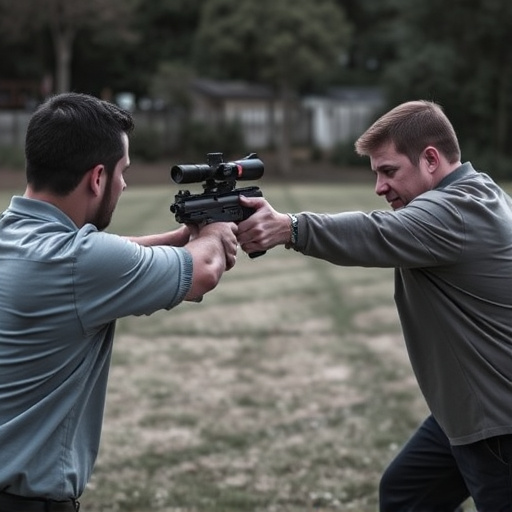
Stopping power ratings for stun guns are designed to quantify their effectiveness in incapacitating an assailant, focusing on the neuromuscular effects of stun devices. These ratings typically measure the intensity and duration of the electric current delivered by the stun gun, which disrupts nerve signals to the muscles, causing temporary paralysis. The most common rating systems consider factors like joules (a unit of energy) and voltage, with higher values indicating more powerful shocks.
However, it’s crucial to note that these ratings don’t always reflect real-world performance. Variables such as the stun gun’s probe design, contact area, and the target’s physical condition can significantly influence the neuromuscular effects, leading to variations in stopping power despite similar rating numbers. Therefore, understanding both the technical specifications and practical applications of stun guns is essential when assessing their effectiveness.
Factors Influencing Stun Device Effectiveness

The effectiveness of a stun gun, or electroshock weapon, is influenced by several factors that contribute to its ability to incapacitate a target through neuromuscular effects. One key aspect is the electrical current and voltage delivered by the device. Higher voltage can lead to stronger muscle contractions, which in turn results in a quicker and more powerful stun. However, it’s essential to maintain a balance; extremely high voltages might cause serious harm or even be fatal if not properly controlled.
Another crucial element is the contact area and continuity of the circuit. The device’s probes must make good contact with the target’s body to complete the electrical circuit. Proper probe design and placement ensure optimal neuromuscular effects, enabling the stun gun to disrupt motor function and cause temporary paralysis. Additionally, environmental conditions like weather and surface conductivity can impact performance, necessitating users to be aware of these factors for maximum effectiveness.
Safety Considerations and Training for Stun Gun Use
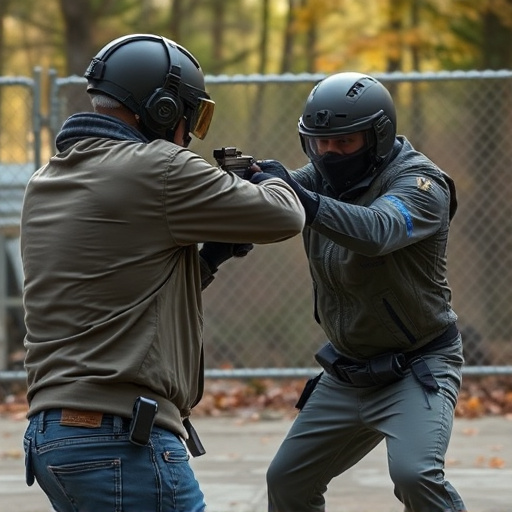
The safe and effective use of a stun gun requires an understanding of its neuromuscular effects and proper training. These devices work by delivering an electric shock that interferes with the nervous system, causing muscles to contract uncontrollably. This disruption can immobilize an attacker for a brief period, allowing the user to escape or call for help. However, it’s crucial to remember that stun guns are not bulletproof solutions and should be used as a last resort when facing physical harm.
Training is essential to ensure users understand the device’s range, activation mechanisms, and safe handling procedures. Proper training also teaches individuals how to aim accurately, minimizing the risk of unintended targets or bystanders. It covers de-escalation techniques and what to do after using a stun gun, including providing first aid if necessary. Safety considerations include regular maintenance of the device and being aware of local laws regarding stun gun ownership and use.
Legal Implications and Regulatory Frameworks

The legal implications surrounding stun guns vary widely across jurisdictions, reflecting complex societal and regulatory debates. Many countries have strict regulations in place regarding the ownership and use of stun devices due to their potential for misuse and the neuromuscular effects they can have on targets. These devices temporarily disable individuals through electrical impingement, affecting the body’s neuromuscular system and leading to muscle spasms, loss of balance, and temporary paralysis.
Regulatory frameworks often dictate who can legally possess stun guns, the power ratings allowed, and under what circumstances they can be employed. Some regions permit their use only by trained professionals or law enforcement officers, while others may restrict them to personal defense scenarios. Understanding these legal boundaries is essential for individuals considering the acquisition of a stun gun to ensure compliance with local laws and avoid potential consequences.
The neuromuscular effects of stun devices, as explored in this article, highlight their potential as non-lethal self-defense tools. Understanding the science behind these devices and their stopping power ratings is crucial for both users and regulators. While these weapons can provide a layer of personal safety, factors like device design, user training, and legal frameworks significantly influence their effectiveness. As the use of stun guns continues to gain traction, ongoing research and responsible regulation are essential to ensure their safe and efficient deployment while mitigating potential risks.

